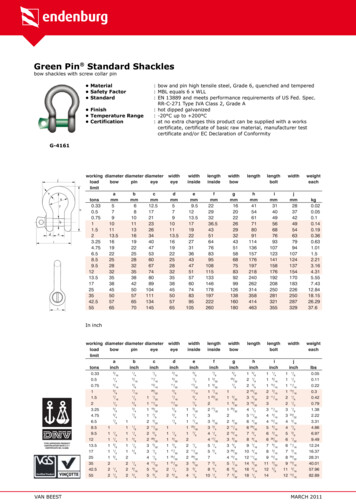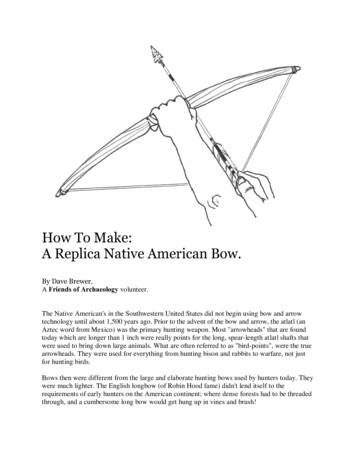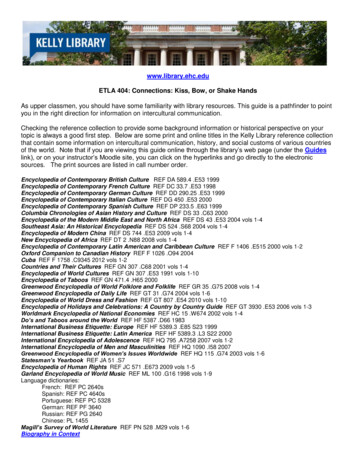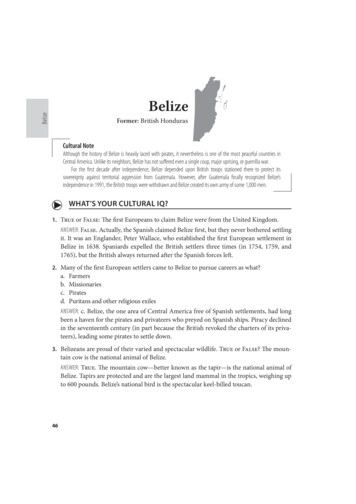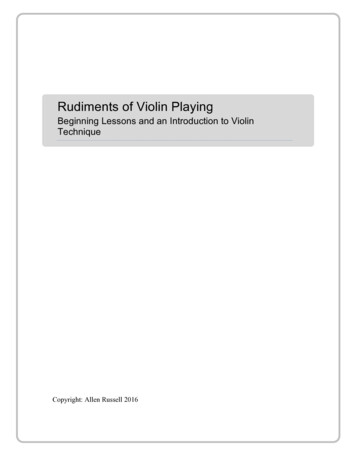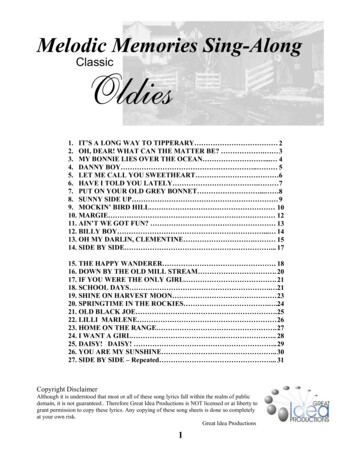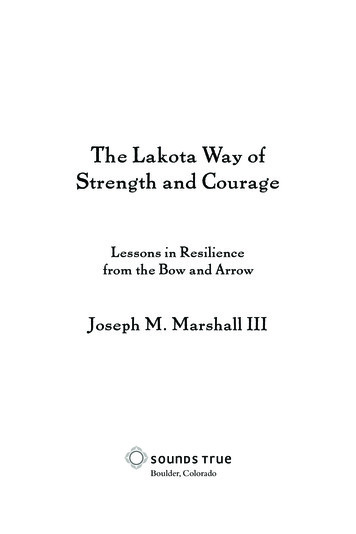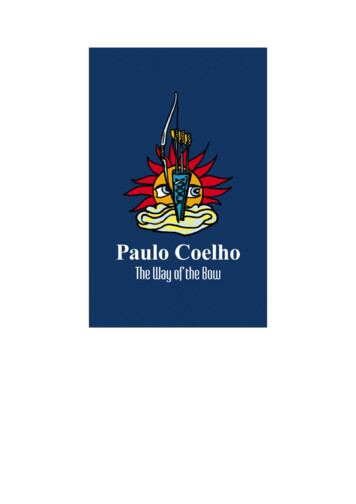
Transcription
Paulo CoelhoTHE WAY OF THE BOWTranslated by Margaret Jull Costa
The Way of the BowOriginal title: O Caminho do arco 2003, Paulo m Cover and illustrations by Pavel Rut, 2011Translated into English by Margaret Jull Costa, 2003.Published in association with Sant Jordi Asociados, Barcelona, Spain.All rights reserved.No part of this publication may be reproduced partially or in its entirety, without theprior permission of the author.ISBN: XXXXXXXXXXX
A prayer without a deed is an arrow without a bow-string;A deed without a prayer is a bow-string without an arrow.ELLA WHEELER WILCOX
Tetsuya.’‘The boy looked at the stranger, startled.‘No one in this city has ever seen Tetsuya holding a bow,’he replied. ‘Everyone here knows him as a carpenter.’‘Maybe he gave up, maybe he lost his courage, that doesn’tmatter to me,’ insisted the stranger. ‘But he cannot beconsidered to be the best archer in the country if he hasabandoned his art. That’s why I’ve been travelling all thesedays, in order to challenge him and put an end to a reputationhe no longer deserves.’The boy saw there was no point in arguing; it was best totake the man to the carpenter’s shop so that he could see withhis own eyes that he was mistaken.Tetsuya was in the workshop at the back of his house. Heturned to see who had come in, but his smile froze when hiseyes fell on the long bag that the stranger was carrying.‘It’s exactly what you think it is,’ said the new arrival. ‘Idid not come here to humiliate or to provoke the man who hasbecome a legend. I would simply like to prove that, after allmy years of practice, I have managed to reach perfection.’Tetsuya made as if to resume his work: he was just puttingthe legs on a table.‘A man who served as an example for a whole generationcannot just disappear as you did,’ the stranger went on. ‘Ifollowed your teachings, I tried to respect the way of the bow,and I deserve to have you watch me shoot. If you do this, I
will go away and I will never tell anyone where to find thegreatest of all masters.’The stranger drew from his bag a long bow made fromvarnished bamboo, with the grip slightly below centre. Hebowed to Tetsuya, went out into the garden and bowed againtowards a particular place. Then he took out an arrow fletchedwith eagle feathers, stood with his legs firmly planted on theground, so as to have a solid base for shooting, and with onehand brought the bow in front of his face, while with the otherhe positioned the arrow.The boy watched with a mixture of glee and amazement.Tetsuya had now stopped working and was observing thestranger with some curiosity.With the arrow fixed to the bow-string, the stranger raisedthe bow so that it was level with the middle of his chest. Helifted it above his head and, as he slowly lowered his handsagain, began to draw the string back.By the time the arrow was level with his face, the bow wasfully drawn. For a moment that seemed to last an eternity,archer and bow remained utterly still. The boy was looking atthe place where the arrow was pointing, but could see nothing.Suddenly, the hand on the string opened, the hand waspushed backwards, the bow in the other hand described agraceful arc, and the arrow disappeared from view only toreappear in the distance.‘Go and fetch it,’ said Tetsuya.The boy returned with the arrow: it had pierced a cherrywhich he found on the ground, forty metres away.Tetsuya bowed to the archer, went to a corner of hisworkshop and picked up what looked like a slender piece ofwood, delicately curved, wrapped in a long strip of leather. He
slowly unwound the leather and revealed a bow similar to thestranger’s, except that it appeared to have seen far more use.‘I have no arrows, so I’ll need to use one of yours. I will doas you ask, but you will have to keep the promise you made,never to reveal the name of the village where I live. If anyoneasks you about me, say that you went to the ends of the earthtrying to find me and eventually learned that I had been bittenby a snake and had died two days later.’The stranger nodded and offered him one of his arrows.Resting one end of the long bamboo bow against the walland pressing down hard, Tetsuya strung the bow. Then,without a word, he set off towards the mountains.The stranger and the boy went with him. They walked foran hour, until they reached a large crevice between two rocksthrough which flowed a rushing river, which could only becrossed by means of a fraying rope bridge almost on the pointof collapse.Quite calmly, Tetsuya walked to the middle of the bridge,which swayed ominously; he bowed to something on the otherside, loaded the bow just as the stranger had done, lifted it up,brought it back level with his chest and fired.The boy and the stranger saw that a ripe peach, abouttwenty metres away, had been pierced by the arrow.‘You pierced a cherry, I pierced a peach,’ said Tetsuya,returning to the safety of the bank. ‘The cherry is smaller. Youhit your target from a distance of forty metres, mine was halfthat. You should, therefore, be able to repeat what I have justdone. Stand there in the middle of the bridge and do as I did.’Terrified, the stranger made his way to the middle of thedilapidated bridge, transfixed by the sheer drop below his feet.He performed the same ritual gestures and shot at the peachtree, but the arrow sailed past.
When he returned to the bank, he was deathly pale.‘You have skill, dignity and posture,’ said Tetsuya. ‘Youhave a good grasp of technique and you have mastered thebow, but you have not mastered your mind. You know how toshoot when all the circumstances are favourable, but if you areon dangerous ground, you cannot hit the target. The archercannot always choose the battlefield, so start your trainingagain and be prepared for unfavourable situations. Continue inthe way of the bow, for it is a whole life’s journey, butremember that a good, accurate shot is very different from onemade with peace in your soul.’The stranger made another deep bow, replaced his bow andhis arrows in the long bag he carried over his shoulder, andleft.On the way back, the boy was exultant.‘You showed him, Tetsuya! You really are the best!’‘We should never judge people without first learning tohear and to respect them. The stranger was a good man; he didnot humiliate me or try to prove he was better than me, eventhough he may have given that impression. He wanted to showoff his art and to have it recognised, even though he gave theimpression that he was challenging me. Besides, having toconfront unexpected trials is all part of the way of the bow,and that was precisely what the stranger allowed me to dotoday.’‘He said that you were the best, and I didn’t even know youwere a master archer. So why do you work as a carpenter?’‘Because the way of the bow serves for everything, and mydream was to work with wood. Besides, an archer who followsthe way does not need a bow or an arrow or a target.’‘Nothing interesting ever happens in this village, and nowsuddenly here I am face to face with the master of an art that
no one even cares about any more,’ said the boy, his eyesshining. ‘What is the way of the bow? Can you teach me?’‘Teaching it isn’t hard. I could do that in less than an hour,while we’re walking back to the village. The difficult thing isto practise it every day, until you achieve the necessaryprecision.’The boy’s eyes seemed to be begging him to say yes.Tetsuya walked in silence for nearly fifteen minutes and whenhe spoke again, his voice sounded younger:‘Today I am contented. I did honour to the man who, manyyears ago, saved my life and, because of that, I will teach youall the necessary rules, but I can do no more than that. If youunderstand what I tell you, you can use those teachings as youwish. Now, a few minutes ago, you called me master. What isa master? I would say that he is not someone who teachessomething, but someone who inspires the student to do his bestto discover a knowledge he already has in his soul.’And as they came down the mountain, Tetsuya explainedthe way of the bow.
ALLIESThe archer who does not share with others the joy of the bowand the arrow will never know his own qualities and defects.Therefore, before you begin anything, seek out your allies,people who are interested in what you are doing.I’m not saying ‘seek out other archers’. I’m saying: findpeople with other skills, because the way of the bow is nodifferent from any other path that is followed with enthusiasm.Your allies will not necessarily be the kind of dazzlingpeople to whom everyone looks up and of whom they say:‘There’s none better.’ On the contrary, they are people who arenot afraid of making mistakes and who do, therefore, makemistakes, which is why their work often goes unrecognised.Yet they are just the kind of people who transform the worldand, after many mistakes, manage to do something that canmake a real difference in their community.They are people who can’t bear to sit around waiting forthings to happen in order to decide which attitude to adopt;they decide as they act, well aware that this could prove highlydangerous.Living with such people is important for an archer becausehe needs to realise that before he faces the target, he must firstfeel free enough to change direction as he brings the bow up tohis chest. When he opens his hand and releases the string, heshould say to himself: ‘As I was drawing the bow, I travelled along road. Now I release this arrow knowing that I took thenecessary risks and gave of my best.’
The best allies are those who do not think like everyoneelse. That is why when you seek companions with whom youcan share your enthusiasm for archery, trust your intuition andpay no attention to what anyone else may say. People alwaysjudge others by taking as a model their own limitations, andother people’s opinions are often full of prejudice and fear.Join with all those who experiment, take risks, fall, get hurtand then take more risks. Stay away from those who affirmtruths, who criticise those who do not think like them, peoplewho have never once taken a step unless they were sure theywould be respected for doing so, and who prefer certainties todoubts.Join with those who are open and not afraid to bevulnerable: they understand that people can only improve oncethey start looking at what their fellows are doing, not in orderto judge them, but to admire them for their dedication andcourage.You might think that archery would be of no interest to, say,a baker or a farmer, but I can assure you that they willintroduce whatever they see into what they do. You will do thesame: you will learn from the good baker how to use yourhands and how to get the right mix of ingredients. You willlearn from the farmer to have patience, to work hard, torespect the seasons and not to curse the storms, because itwould be a waste of time.Join with those who are as flexible as the wood of your bowand who understand the signs along the way. They are peoplewho do not hesitate to change direction when they encountersome insuperable barrier, or when they see a betteropportunity. They have the qualities of water: flowing aroundrocks, adapting to the course of the river, sometimes forminginto a lake until the hollow fills to overflowing, and they cancontinue on their way, because water never forgets that the seais its destiny and that sooner or later it must be reached.
Join with those who have never said: ‘Right, that’s it, I’mgoing no further,’ because as sure as spring follows winter,nothing ever ends; after achieving your objective, you muststart again, always using everything you have learned on theway.Join with those who sing, tell stories, take pleasure in life,and have joy in their eyes, because joy is contagious and canprevent others from becoming paralysed by depression,loneliness and difficulties.Join with those who do their work with enthusiasm, andbecause you could be as useful to them as they are to you, tryto understand their tools too and how their skills could beimproved.The time has come, therefore, to meet your bow, yourarrow, your target and your way.
THE BOWThe bow is life: the source of all energy.The arrow will leave one day.The target is a long way off.But the bow will stay with you, and you must know how tolook after it.It requires periods of inaction - a bow that is always armedand braced loses its strength. Therefore, allow it to rest, torecover its firmness; then, when you draw the bow-string, thebow will be content, with all its strength intact.A bow has no conscience: it is a prolongation of the handand desire of the archer. It can serve to kill or to meditate.Therefore, always be clear about your intentions.A bow is flexible, but it has its limits. Stretching it beyondits capacity will break it or exhaust the hand holding it.Therefore, try to be in harmony with your instrument andnever ask more than it can give.A bow rests or lies in the hand of the archer, but the hand ismerely the place where all the muscles of the body, all theintentions of the archer and all the effort of shooting isconcentrated. Therefore, in order to maintain elegance ofposture while keeping the bow drawn, make sure that everypart does only what is necessary and do not dissipate yourenergies. That way, you will be able to shoot many arrowswithout tiring.
In order to understand your bow, it must become part ofyour arm and an extension of your thoughts.
THE ARROWThe arrow is the intention.It is what unites the strength of the bow with the centre ofthe target.The intention must be crystal-clear, straight and balanced.Once the arrow has gone, it will not come back, so it isbetter to interrupt a shot, because the movements that led up toit were not sufficiently precise and correct, than to actcarelessly, simply because the bow was fully drawn and thetarget was waiting.But never hold back from firing the arrow if all thatparalyses you is fear of making a mistake. If you have madethe right movements, open your hand and release the string.Even if the arrow fails to hit the target, you will learn how toimprove your aim next time.If you never take a risk, you will never know what changesyou need to make.Each arrow leaves a memory in your heart, and it is the sumof those memories that will make you shoot better and better.
THE TARGETThe target is the objective to be reached.It was chosen by the archer and though it is a long way off,we cannot blame it when we fail to hit it. In this lies the beautyof the way of the bow: you can never excuse yourself bysaying that your opponent was stronger than you.You were the one who chose the target and you areresponsible for it.The target can be larger, smaller, to the right or the left, butyou always have to stand before it, respect it and bring itcloser mentally. Only when it is at the very end of your arrowshould you release the bow-string.If you view the target as the enemy, you might well hit thetarget, but you will not improve anything inside yourself. Youwill go through life trying only to place an arrow in the centreof a piece of paper or wood, which is absolutely pointless. Andwhen you are with other people, you will spend your timecomplaining that you never do anything interesting.That is why you must choose your target, do your best to hitit, and always regard it with respect and dignity; you need toknow what it means and how much effort, training andintuition was required on your part.When you look at the target, do not concentrate on thatalone, but on everything going on around it, because the arrow,when it is shot, will encounter factors you failed to take intoaccount, like wind, weight, distance.
You must understand the target. You need to be constantlyasking yourself: ‘If I am the target, where am I? How would itlike to be hit, so as to give the archer the honour he deserves?’The target only exists if the archer exists. What justifies itsexistence is the desire of the archer to hit it, otherwise it wouldbe a mere inanimate object, an insignificant piece of paper orwood.Just as the arrow seeks the target, so the target also seeksthe arrow, because it is the arrow that gives meaning to itsexistence; it is no longer just a piece of paper; for an archer, itis the centre of the world.
POSTUREOnce you have understood the bow, the arrow and the target,you must have the serenity and elegance necessary to learnhow to shoot.Serenity comes from the heart. Although the heart is oftentormented by thoughts of insecurity, it knows that —throughcorrect posture— it will be able to do its best.Elegance is not something superficial, but the way in whicha man can do honour to his life and his work. If youoccasionally find the posture uncomfortable, do not think of itas false or artificial; it is real because it is difficult. It allowsthe target to feel honoured by the dignity of the archer.Elegance is not the most comfortable of postures, but it isthe best posture if the shot is to be perfect.Elegance is achieved when everything superfluous has beendiscarded, and the archer discovers simplicity andconcentration; the simpler and more sober the posture, themore beautiful.The snow is lovely because it has only one colour, the sea islovely because it appears to be a completely flat surface, butboth sea and snow are deep and know their own qualities.
HOW TO HOLD THE ARROWTo hold the arrow is to be in touch with your own intention.You must look along the whole length of the arrow, checkthat the feathers guiding its flight are well placed, and makesure that the point is sharp.Ensure that it is straight and that it has not been bent ordamaged by a previous shot.In its simplicity and lightness, the arrow can appear fragile,but the strength of the archer means that it can carry the energyof his body and mind a long way. Legend has it that a singlearrow once sank a ship, because the man who shot it knewwhere the wood was weakest and so made a hole that allowedthe water to seep silently into the hold, thus putting paid to thethreat of those would-be invaders of his village.The arrow is the intention that leaves the archer’s hand andsets off towards the target, that is, it is free in its flight and willfollow the path chosen for it when it was released.It will be affected by the wind and by gravity, but that ispart of its trajectory; a leaf does not cease to be a leaf merelybecause a storm tore it from the tree.A man’s intention should be perfect, straight, sharp, firm,precise. No one can stop it as it crosses the space separating itfrom its destiny.
HOW TO HOLD THE BOWKeep calm and breathe deeply.Every movement will be noticed by your allies, who willhelp you if necessary.But do not forget that your opponent is watching you too,and he knows the difference between a steady hand and anunsteady one: therefore, if you are tense, breathe deeply,because that will help you to concentrate at every stage.At the moment when you take up your bow and place it —elegantly— in front of your body, try to go over in your mindevery stage that led up to the preparation of that shot. But dothis without tension, because it is impossible to hold all therules in your head; and with a tranquil mind, as you revieweach stage, you will see again all the most difficult momentsand how you overcame them.This will give you confidence and your hand will stopshaking.
HOW TO DRAW THE BOWSTRINGThebow is a musical instrument, and its sound is mademanifest in the string.The bow-string is a big thing, but the arrow touches onlyone point on it, and all the archer’s knowledge and experienceshould be concentrated on that one small point.If he leans slightly to the right or to the left, if that point isabove or below the line of fire, he will never hit the target.Therefore, when you draw the bow-string, be like amusician playing an instrument. In music, time is moreimportant than space; a group of notes on a line meansnothing, but the person who can read what is written there cantransform that line into sounds and rhythms.Just as the archer justifies the existence of the target, so thearrow justifies the existence of the bow: you can throw anarrow with your hand, but a bow without an arrow is no use atall.Therefore, when you open your arms, do not think ofyourself as stretching the bow. Think of the arrow as the stillcentre and that you are trying to bring the ends of bow andbow-string closer together; touch the string delicately; ask forits co-operation.
HOW TO LOOK AT THE TARGETMany archers complain that, despite having practised the artof archery for many years, they still feel their heart beatinganxiously, their hands shaking, their aim failing. They need tounderstand that a bow or an arrow can change nothing, but thatthe art of archery makes our mistakes more obvious.On a day when you are out of love with life, your aim willbe confused, difficult. You will find that you lack the strengthto draw the string back fully, that you cannot get the bow tobend as it should.And when you see that your aim is poor that morning, youwill try to find out what could have caused such imprecision;this will mean confronting the problem that is troubling you,but which, up until then, has remained hidden.The opposite can happen too: your aim is true, the stringhums like a musical instrument, the birds are singing allaround. Then you realise that you are giving of your best.Nevertheless, do not allow yourself to be carried away byhow you shoot in the morning, whether well or badly. Thereare many more days ahead, and each arrow is a life in itself.Use your bad moments to discover what makes youtremble. Use your good moments to find your road to innerpeace.But do not stop either out of fear or joy: the way of the bowhas no end.
THE MOMENT OF RELEASEThere are two types of shot.The first is the shot made with great precision, but withoutany soul. In this case, although the archer may have a greatmastery of technique, he has concentrated solely on the targetand because of this he has not evolved, he has become stale,he has not managed to grow, and, one day, he will abandon theway of the bow because he finds that everything has becomemere routine.The second type of shot is the one made with the soul.When the intention of the archer is transformed into the flightof the arrow, his hand opens at the right moment, the sound ofthe string makes the birds sing, and the gesture of shootingsomething over a distance provokes —paradoxically enough—a return to and an encounter with oneself.You know the effort it took to draw the bow, to breathecorrectly, to concentrate on the target, to be clear about yourintention, to maintain elegance of posture, to respect the target,but you need to understand, too, that nothing in this worldstays with us for very long: at a given moment, your hand willhave to open and allow your intention to follow its destiny.Therefore, the arrow must leave, however much you loveall the steps that led to the elegant posture and the correctintention, and however much you admire its feathers, its point,its shape.However, it cannot leave before the archer is ready to shoot,because its flight would be too brief. It cannot leave after the
exact posture and concentration have been achieved becausethe body would be unable to withstand the effort and the handwould begin to shake.It must leave at the moment when bow, archer and targetare at the same point in the universe: this is called inspiration.
REPETITIONThe gesture is the incarnation of the verb, that is, an action isa thought made manifest.A small gesture betrays us, so we must polish everything,think about details, learn the technique in such a way that itbecomes intuitive. Intuition has nothing to do with routine, butwith a state of mind that is beyond technique.So, after much practising, we no longer think about thenecessary movements, they become part of our own existence.But for this to happen, you must practise and repeat.And if that isn’t enough, you must repeat and practise.Look at the skilled farrier working steel. To the untrainedeye, he is merely repeating the same hammer blows.But anyone who knows the way of the bow knows that eachtime he lifts the hammer and brings it down, the intensity ofthe blow is different. The hand repeats the same gesture, but asit approaches the metal, it understands that it must touch itwith more or less force.So it is with repetition, although it may appear to be thesame thing, it is always different.Look at the windmill. To someone who glances at its sailsonly once, they seem to be moving at the same speed,repeating the same movement.But those familiar with windmills know that they arecontrolled by the wind and change direction as necessary.
The hand of the farrier was trained by repeating the gestureof hammering thousands of times. The sails of the windmillcan move fast when the wind blows hard and thus ensure thatits gears run smoothly.The archer allows many arrows to go far beyond the target,because he knows that he will only learn the importance ofbow, posture, string and target, by repeating his gesturesthousands of time and by not being afraid of making mistakes.And his true allies will never criticise him, because theyknow that practise is necessary, that it is the only way in whichhe can perfect his instinct, his hammer blow.And then comes the moment when he no longer has tothink about what he is doing. From then on, the archerbecomes his bow, his arrow and his target.
HOW TO OBSERVE THE FLIGHTOF THE ARROWOnce the arrow has been shot, there is nothing more thearcher can do, except follow its path to the target. From thatmoment on, the tension required to shoot the arrow has nofurther reason to exist.Therefore, the archer keeps his eyes fixed on the flight ofthe arrow, but his heart rests, and he smiles.The hand that released the bow-string is thrust back, thehand holding the bow moves forward, the archer is forced toopen wide his arms and confront, chest exposed and with asincere heart, the gaze of both allies and opponents.If he has practised enough, if he has managed to develophis instinct, if he has maintained elegance and concentrationthroughout the whole process of shooting the arrow, he will, atthat moment, feel the presence of the universe and will see thathis action was just and deserved.Technique allows both hands to be ready, breathing to beprecise, the eyes to be trained on the target. Instinct allows themoment of release to be perfect.Anyone passing nearby and seeing the archer with his armsopen, his eyes following the arrow, will think that nothing ishappening. But his allies know that the mind of the personwho made the shot has changed dimensions, it is now in touchwith the whole universe; the mind continues to work, learningall the positive things about that shot, correcting possible
errors, accepting its good qualities, and waiting to see how thetarget reacts when it is hit.When the archer draws the bow-string, he can see thewhole world in his bow.When he follows the flight of the arrow, that world growscloser to him, caresses him and gives him a perfect sense ofduty fulfilled.Each arrow flies differently. You can shoot a thousandarrows and each one will follow a different trajectory: that isthe way of the bow.
THE ARCHER WITHOUT BOW,WITHOUT ARROW,WITHOUT TARGETThe archer learns when he forgets all about the rules of theway of the bow and goes on to act entirely on instinct. Inorder, though, to be able to forget the rules, it is necessary torespect them and to know them.When he reaches this state, he no longer needs theinstruments that helped him to learn. He no longer needs thebow or the arrows or the target, because the path is moreimportant than the thing that first set him on that path.In the same way, the student learning to read reaches apoint when he frees himself from the individual letters andbegins to make words out of them.However, if the words were all run together, they wouldmake no sense at all or would make understanding extremelyhard; there have to be spaces between the words.Between one action and the next, the archer rememberseverything he has done, he talks with his allies, he rests and iscontent with the fact of being alive.The way of the bow is the way of joy and enthusiasm, ofperfection and error, of technique and instinct.‘But you will only learn this if you keep shooting yourarrows.’By the time Tetsuya stopped talking, they had reached thecarpentry workshop.
‘Thank you for your company,’ he said to the boy.But the boy did not leave.‘How can I know if I’m doing the right thing? How can I besure that my eyes are concentrating, that my posture is elegant,that I’m holding the bow correctly?’‘Visualise the perfect master always by your side and doeverything to revere him and to honour his teachings. Thismaster, whom many people call God, although some call him‘the thing‚’ and others ‘talent’, is always watching us.He deserves the best.Remember your allies too: you must support them, becausethey will help you at those moments when you need help. Tryto develop the gift of kindness: this gift will allow you to bealways at peace with your heart. But, above all, never forgetthat what I have told you might perhaps be words ofinspiration, but they will only make sense if you experiencethem yourself.’Tetsuya held out his hand to say goodbye, but the boy said:‘One other thing, how did you learn to shoot a bow?’Tetsuya thought for a moment: was it worth telling thestory? Since this had been a special day, he opened the door tohis workshop and said:‘I’m going to make some tea, and I’m going to tell you thestory, but you have to promise the same thing I made thestranger promise —never tell anyone about my skill as anarcher.’He went in, put on the light, wrapped his bow up again inthe long strip of leather and placed it out of sight. If anyonestumbled upon it,
slowly unwound the leather and revealed a bow similar to the stranger’s, except that it appeared to have seen far more

